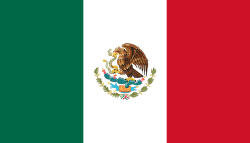
Democracy in Mexico dates to the establishment of the federal republic of Mexico in 1824. After a long history under the Spanish Empire (1521–1821), Mexico gained its independence in 1821 and became the First Mexican Empire led by royalist military officer Agustín de Iturbide. Three years later, a federal republic was created under the Constitution of 1824. However, the republic was truncated by a series of military coups, most notably that of politician-general Antonio López de Santa Anna. Santa Anna held immense sway over the fledgling Mexican democracy until 1855, when he was ousted by liberal politicians.
The liberals drafted and ratified the Constitution of 1857, which enshrined rights such as universal male suffrage and eliminated Church and military privileges. The overthrow of Santa Anna, however, led to widespread dissatisfaction among conservative Mexicans and led to a twenty-two-year conflict and two wars between conservatives and liberals. In 1862, on the invitation of Mexican conservatives, Maximilian Habsburg was crowned Emperor of Mexico after a successful French invasion of the country.
From 1876 to 1911, regular elections were held, but the electorate remained politically unengaged. This era was known as the Porfiriato – the presidency of Porfirio Díaz, who ascended to power via military coup in 1876 and held power directly and indirectly until 1910. As resentment towards Díaz increased, the Mexican Revolution broke out in 1910 and caused a civil war, which ended with the creation of the new Constitution after its ratification on 5 February 1917.
Mexican politics was then dominated by the secular Constitutionalists, who had won the ensuing civil war. Regular elections were held, but results were often manipulated. Though the "anti-re-electionist principle" still stood, mandating that incumbent presidents could not be re-elected, presidents often nominated their successors. The result was that the ruling Institutional Revolutionary Party (PRI) held near-complete control over the electoral mechanism, essentially turning Mexico into a one-party state until 1988, when its left-wing factions broke off. Women's suffrage was introduced in 1953.
Mexican politics saw change in 2000 when the conservative opposition National Action Party (PAN) candidate Vicente Fox won the presidential election.[1] He was succeeded by the next candidate of the PAN, Felipe Calderón, in 2006.[2] The PRI returned to power in 2012, after Enrique Peña Nieto won the presidency,[3] but was defeated by Andrés Manuel López Obrador's new National Regeneration Movement (MORENA) coalition in 2018.
Mexico was ranked 11th least electoral democracy in Latin America and the Caribbean according to V-Dem Democracy indices in 2023 with a score of 0.598 out of one.[4][5]
- ^ Meyer, Michael C. (2014). The course of Mexican history. Sherman, William L.,, Deeds, Susan M. (Tenth ed.). New York. ISBN 9780199913817. OCLC 865717332.
{{cite book}}: CS1 maint: location missing publisher (link) - ^ Mckinley, James C. Jr.; Thompson, Ginger (6 July 2006). "Calderón Wins Narrow Victory in Mexico Election". The New York Times.
- ^ "Enrique Peña Nieto takes office as Mexico's president". TheGuardian.com. 2 December 2012.
- ^ V-Dem Institute (2023). "The V-Dem Dataset". Retrieved 14 October 2023.
- ^ Democracy Report 2023, Table 3, V-Dem Institute, 2023
© MMXXIII Rich X Search. We shall prevail. All rights reserved. Rich X Search
